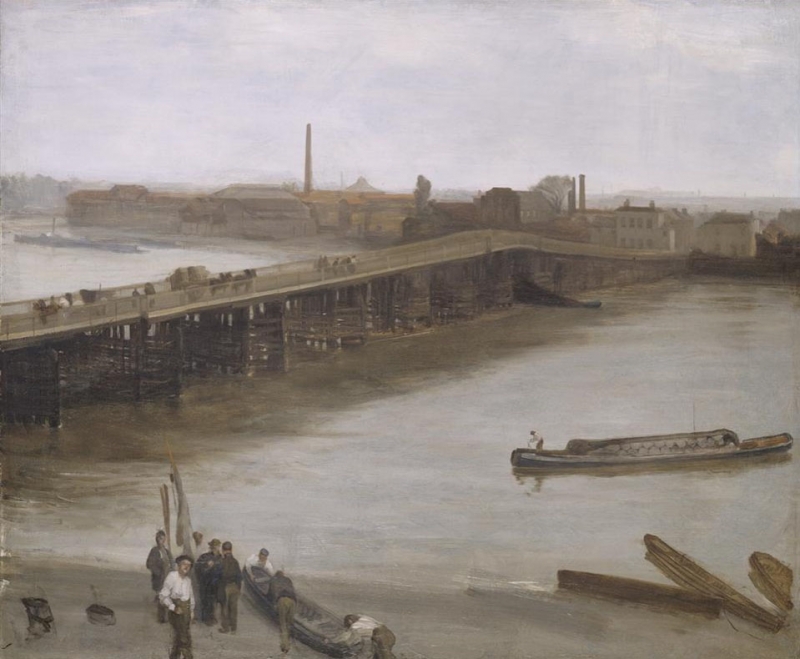Titles
Several possible titles have been suggested:
- 'Old Battersea Bridge' (1865, Royal Academy of Arts). 1
- 'Harmonie en gris et brun' (1883, Petit). 2
- 'Brown and Silver. Old Battersea Bridge' (1892, Goupil). 3
- 'Old Battersea Bridge' (1904, Royal Scottish Academy). 4
- 'Old Battersea Bridge' and 'Brown and Silver: Old Battersea Bridge' (1905, ISSPG). 5
- 'Brown and Silver: Old Battersea Bridge' (1980, YMSM). 6
Brown and Silver: Old Battersea Bridge , based on the Goupil title of 1892, with the punctuation altered to conform to other titles, is the generally accepted title.
Description
A riverscape, in horizontal format. In the foreground at lower left several workmen stand on the shore by a small boat. At right, several more skiffs are pulled up on the beach. On the river, close to the shore at right, is a loaded barge. In the middle distance a long wooden bridge crosses the river, busy with people and traffic, rising to a high point towards the right, and then down to the south bank of the Thames. There are buildings on the far bank: warehouses and factories, with a tall chimney to left of centre, and, on the horizon at right, the silhouette of a great building.
Site
Brown and Silver: Old Battersea Bridge shows the view down the river Thames from Whistler's house at 7 Lindsey Row, Chelsea, with the factories of Battersea seen across the river and the Crystal Palace on the horizon.
Battersea Bridge crosses the river Thames between Chelsea and Battersea. Brown and Silver: Old Battersea Bridge is the earliest oil painting by Whistler depicting the whole bridge. From Lindsey Row he looked south across the river Thames, with the bridge to left. Small boats landed on the shore below his house – the Greaves boatyard and Druce, a coal merchant, were based there – and barges unloaded at the jetties. The factories and parks of Battersea were across the river.
The old timber Battersea Bridge dated back to 1771-1772, and was built by John Philips under the direction of Henry Holland. By the middle of the 19th century it was decaying and badly battered. A contemporary tourist guide described it as ‘coarse, unseemly and inconvenient in character’. 7 In 1879 it was described as 'one of the old-fashioned timber structures, which will before long have to be removed and a new bridge built in its place.' 8 The old bridge was closed to traffic in 1883 and demolished in 1890. Sir Joseph Bazalgette's bridge was built to replace it between 1886 and 1890.
Between 1859 and 1879 Whistler portrayed the old bridge in drawings, etchings, lithographs, lithotints, paintings, as well as on a folding screen and on a wall in his house in Chelsea. Whistler's studies were drawn from either a boat, the shore, or a jetty near his house on Lindsey Row.
Etchings – Under Old Battersea Bridge [168] and Old Battersea Bridge [188] – focus on the massive piers of the bridge. Single piles supporting a section of bridge (making a T-shaped composition) appear in several drawings (The new Albert Bridge, seen through old Battersea Bridge [M.0480], A span of old Battersea Bridge [M.0481], Old Battersea Bridge [M.0482] and Nocturne: Battersea Bridge [M.0485]), and these also relate to Blue and Silver: Screen, with Old Battersea Bridge [YMSM 139]. The most famous of the T-shaped compositions is the oil painting Nocturne: Blue and Gold - Old Battersea Bridge [YMSM 140], which dates from the early 1870s, and reflects the influence of oriental prints.
Two chalk drawings – Old Battersea Bridge [M.0700] and The Tall Bridge [M.0701], dating from 1878 – are studies for lithographs, The Broad Bridge c011 and The Tall Bridge c012 respectively.
The whole bridge is seen again, rather fuzzily, in another lithograph, Old Battersea Bridge, No. 2 c013, and finally in Old Battersea Bridge c018 (dating from 1879 and 1887). The latter was drawn from a boat at high tide, when the water conceals much of the piers. Similarly, the high tide conceals the considerable height of the piles in the oil painting under discussion, Brown and Silver: Old Battersea Bridge.
Notes:
1: 97th Exhibition of the Royal Academy of Arts, London, 1865 (cat. no. 343).
2: Exposition Internationale de Peinture, Galerie George Petit, Paris, 1883 (cat. no. 6).
3: Nocturnes, Marines & Chevalet Pieces, Goupil Gallery, London, 1892 (cat. no. 31).
4: 78th Exhibition of the Royal Scottish Academy of Painting, Sculpture and Architecture, Royal Scottish Academy, Edinburgh, 1904 (cat. no. 276).
5: Memorial Exhibition of the Works of the late James McNeill Whistler, First President of The International Society of Sculptors, Painters and Gravers, New Gallery, Regent Street, London, 1905 (cat. no. 17) in ordinary and deluxe edition respectively.
6: YMSM 1980 [more] (cat. no. 33).
7: Hall & Hall 1859 [more] , pp. 397-400, 404.
8: Anon., 'Freeing the Bridges', The Times, London, 24 May 1879, p. 12.
Last updated: 19th December 2020 by Margaret






